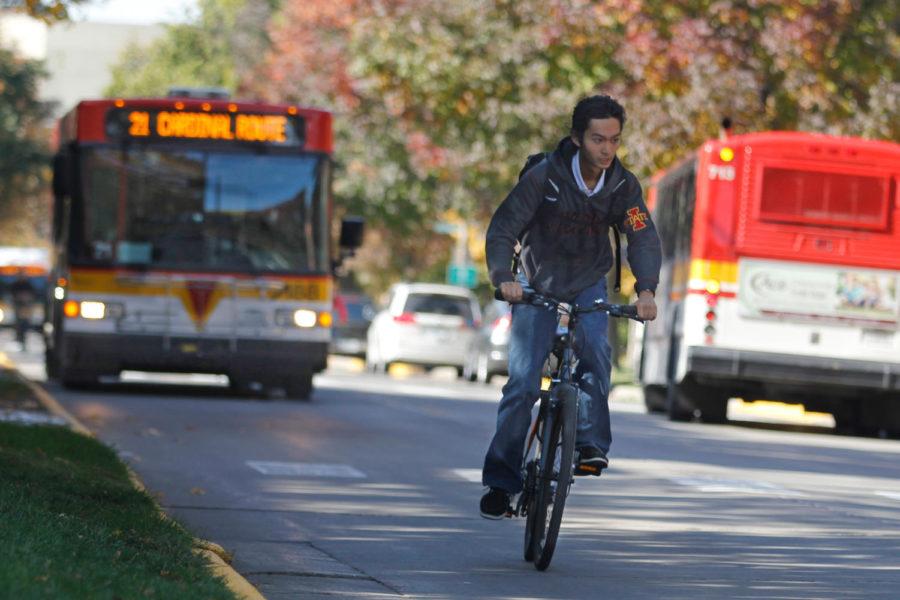Overcrowding leads to more ISU accidents
Brian Achenbach/Iowa State Daily
Every day, hundreds of cyclists compete for road space with drivers, pedestrians, and the CyRide. Iowa State’s campus follows the same rules for cyclists as the state of Iowa, which means that bicycles are given the same rights and responsibilities as any other driver according to the Ames Municipal Code.
September 10, 2014
As the enrollment on campus increases, the amount of bike, foot and motor traffic is also on the rise.
ISU Police Department said there have recently been a number of accidents on campus involving bicyclists and vehicles, including a student on a bicycle being seriously injured when struck by a vehicle on Fourth Street near Jack Trice Stadium on Aug. 29.
“With enrollment increasing on campus, we have more pedestrians, we have more bicyclists, we have more vehicles all the time,” said Anthony Greiter, community outreach officer for the ISU Police.
Greiter said there are many contributing factors to these accidents. One is more prevalent than the others, however.
“There are rules that need to be followed that aren’t being followed on both parts, vehicle operators and bicyclists,” said Greiter.
According to ISU Police, part of the problem is that many people do not know the rules. For optimum safety, bicyclists need to know their rules and vehicle operators need to know the rules for bicyclists as well.
“Accidents are an inherent risk of cycling,” said Kelsey Regan, a coordinator of the Cycling Club.
More accidents are happening on and around campus than are reported, ISU Police said. People also do not report the amount of “missing” accidents, where an accident could have occurred if one party had not swerved out of the way.
Regan said that while accidents cannot be completely prevented, following proper safety procedures could reduce accidents.
“If cyclists want to be safe, then they need to have more safety gear than the law requires,” Regan said.
Bicycle headlights are the only required safety equipment in Ames.
While the law in Ames does not require helmets, they are vital safety devices, according to Regan. Bikers should be using mirrors on the helmet, reflective gear and extra headlights.
“Do as much as you can do to be visible to drivers,” Regan said.
It is not only bicyclists that need to understand and follow traffic safety rules. Grieter said motorists need to understand bicycle safety rules as well.
“Drivers get frustrated that bicyclists don’t ride at or above the speed limit,” said Grieter.
Although cyclists are not able to travel at the same speeds as cars, they are allowed to ride on most Ames roads. North Grand Avenue, Highway 30 and Interstate 35 are the only roads that restrict bicycle traffic.
Bicyclists are required to follow the same rules as cars when on the road. For example, they must stop at stop signs and red lights, and they must use hand signals to display their turning directions.
Those who wish to advocate safe biking in Ames can join a new group called the Ames Bicycle Coalition.
Greiter is part of a new campaign, “Take Care, Be Aware.” The campaign aims to inform the community about how to be safe sharing campus with bicyclists and vehicles.
“Take care of yourself while you are riding, know the rules that apply to your bicycle or vehicle,” Greiter said. “It is important to know the rules of the opposite party, as well as practice being aware of what is going on in the area.”
Regan made it clear that riding a bicycle on campus can never be risk-free.
“Even people who are being extremely safe are still subjected to accidents,” Regan said. “They can never completely be prevented.”

















